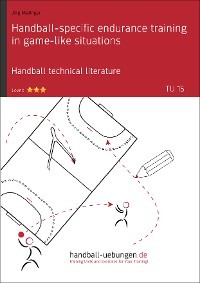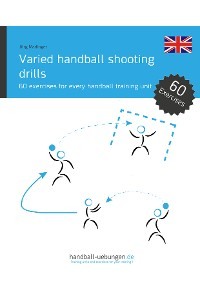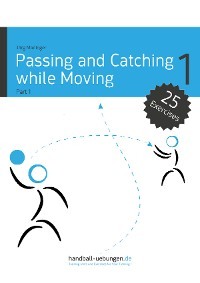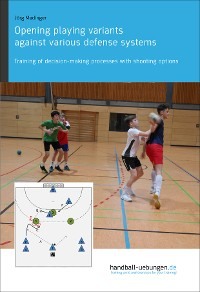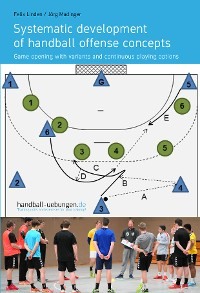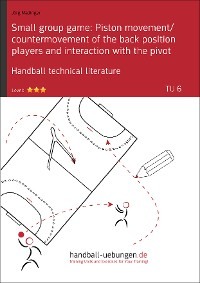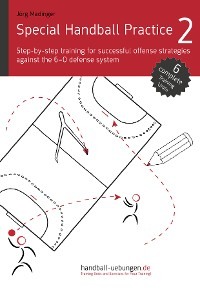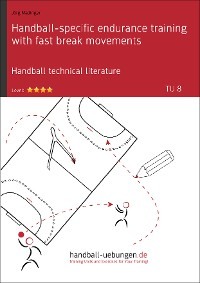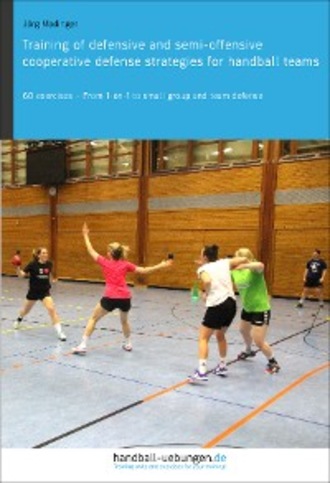
Полная версия
Training of defensive and semi-offensive cooperative defense strategies for handball teams
- Afterwards,


-


- As soon as




- And so on.

No. 6: Stepping forward and moving backward on the left/right back positions
Difficulty level:



Minimum number of players: 8
Equipment required: 6 cones, 2 handballs
Setting:
- Define the running path with six cones as shown in the figure.
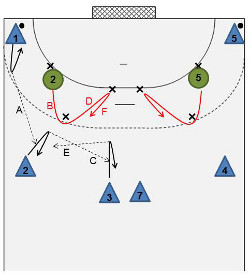
Course:
-


-

-


-

-


-

-

-











2. Exercises on physical contact
No. 7: Pushing attacking players out of the 6-meter zone/Preventing a breakthrough
Difficulty level:


Minimum number of players: 8
Equipment required: In course 2: 1 cone and 2-3 handballs
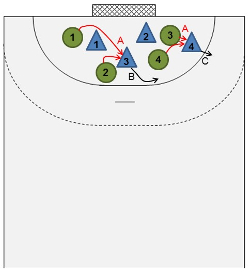
Course 1 (figure 1):
- Make two teams.
- Both teams start at the 6-meter zone; one team defending, the other team attacking.
- Upon the coach’s command, the defending players try to push the attacking players out of the 6-meter zone as fast as possible by getting into physical contact (A) and controlled pushing movements (C).
- The other players try to stay in the 6-meter zone for as long as possible (B). They must not enter the 6-meter zone once they have been pushed out, however.
- Stop the time as soon as all players have been pushed out of the 6-meter zone.
- Switch tasks afterwards. Which team has pushed their opponents out of the 6-meter zone fastest?


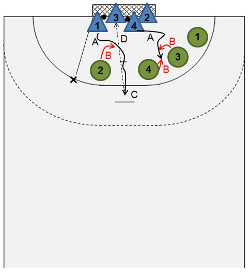
Course 2 (figure 2):
- Make two teams.
- The attacking players have two handballs and start in the goal. The defending players start in the 6-meter zone.
- Make the field smaller with a cone, so that not the entire 6-meter zone is available for playing (see figure).
- Upon the coach’s starting signal, the two attacking players with the ball try to cross the 6-meter zone as fast as possible (A) and to leave it (C) (while holding the ball in their hands).
- The defending players try to stop the attacking players from breaking through and out of the 6-meter zone by collaborating and by getting into physical contact (B).
- If an attacking player manages to break through (C), he passes the ball to a teammate in the goal (D) who then also tries to break through.
- As soon as all players except the last one have left the 6-meter zone, stop the time and switch tasks.
- Which defense team manages to prevent the attacking players from breaking through for the longest time?



No. 8: Preventing an attacking player from breaking through 2-on-1
Difficulty level:


Minimum number of players: 8
Equipment required: 2 cones and one handball per team of 4
Setting:
- Define the finish lines with cones (see figure).
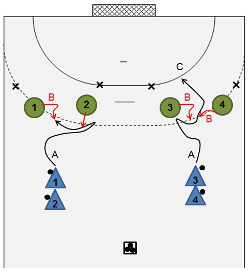
Course:
- The defending players play against a single attacking player (here


-


- The defending players try to prevent


- The defending players must cooperate and get into physical contact with the attacking player.
- If the attacking player breaks through (C), he gets a point.
- Each attacking player must try to break through on each side. Afterwards, change the defending players, so that each player has played defense once (twice for smaller groups).
- Which attacking player has scored highest?

No. 9: Preventing an attacking player from breaking through 3-on1 or 2-on-1
Difficulty level:


Minimum number of players: 8
Equipment required: 2 cones, ball box with sufficient number of handballs
Setting:
- Make teams of three.
- Define the playing field with cones.
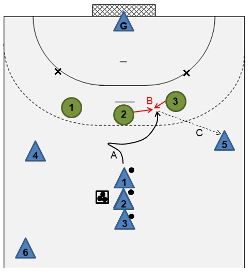
Course 1 (figure 1):
- One team of three starts as defending team, one team as attacking team, the players of the third team serve as feeders/receivers (


- The defending players play against a single attacking player (here

-


- The defending players try to defend against

-

→ Shot from behind the 9-meter line ->

→ Breakthrough and shot within the 9-meter zone (three points for a goal, two points if

→ Pass from within the 9-meter zone to one of the feeders/receivers (C), one point.
- If the defense players tackle

-



- Switch the tasks (









- Each team plays defense one time and offense at least one time.
- Which defending team is best in preventing the attacking players from scoring?
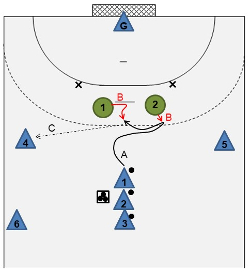
Course 2 (Figure 2):
- The course remains the same; however, now there are only two defending players playing in a slightly smaller field (the defending team of two substitutes one player each after two actions).


3. 1-on-1 defense play
No. 10: Ball familiarization 1-on-1
Difficulty level:


Minimum number of players: 3
Equipment required: 4 cones and 1 handball per group of 3
Setting:
- Make teams of three, each team having one ball and 4 cones.
- The players stand as shown in the figure.
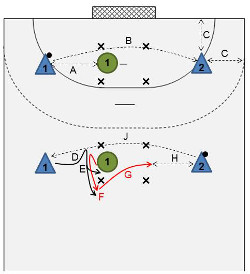
Course:
-


-



-

- After his pass to





- After the action,


-



- Change the defending players after four to five rounds.









No. 11: Basic movements and 1-on-1
Difficulty level:


Minimum number of players: 3
Equipment required: 1 cone and 1 handball per group of 3
Basic setting:




